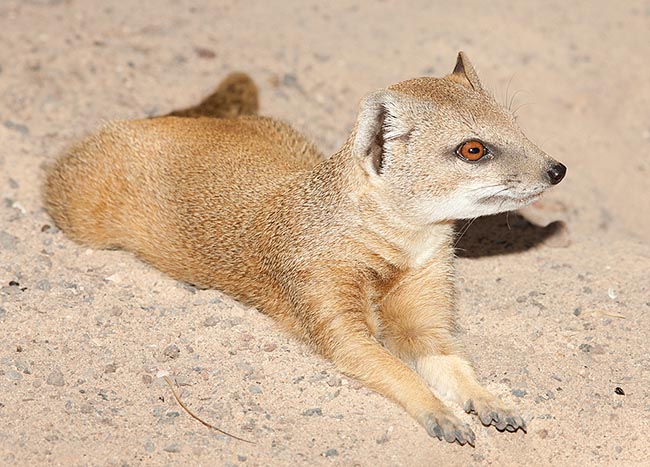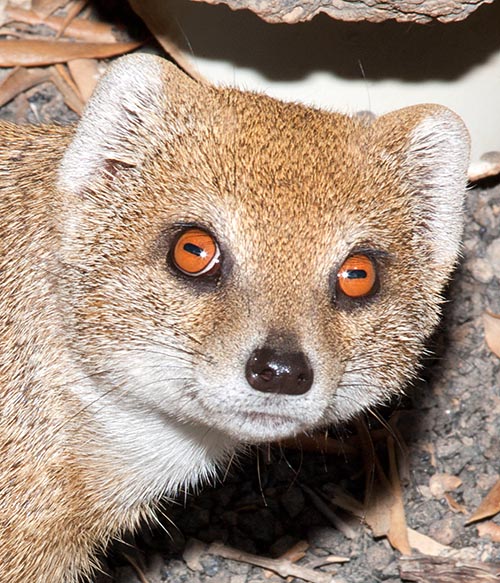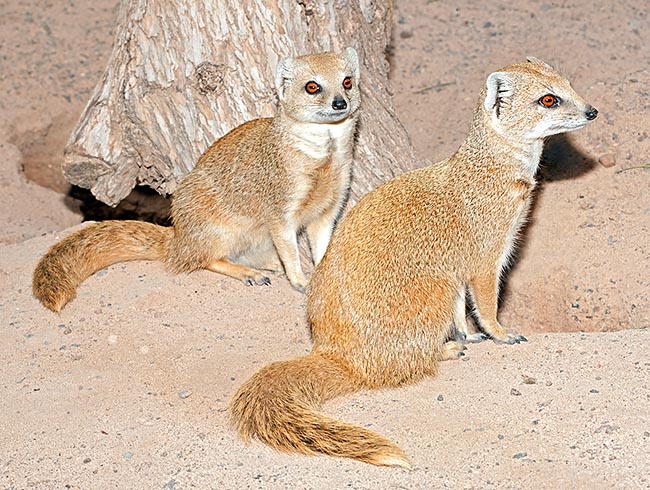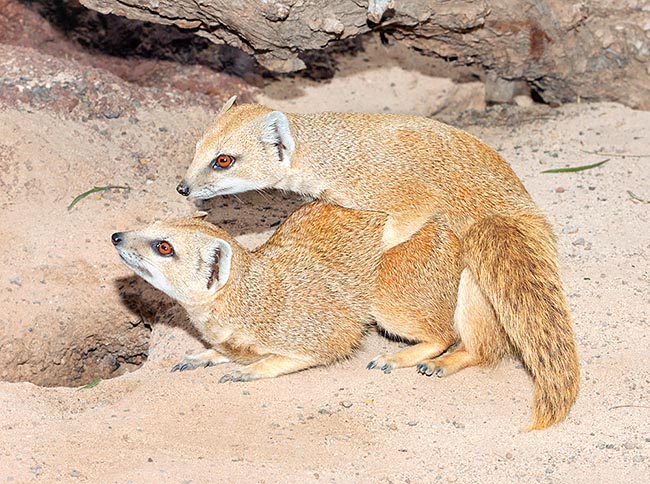Family : Herpestidae

Text © Dr Davide Guadagnini

English translation by Mario Beltramini

Cynictis penicillata eats not only snakes but fruits and all what gets close © Giuseppe Mazza
The yellow mongoose or red meerkat (Cynictis penicillata Cuvier 1829) is a nice mammal belong to the order of the Carnivores (Carnivora) and to the well known family of the Herpestids (Herpestidae) to which belong the so-called “mongooses”.
It is the only species of the genus Cynictis.
The species Cynictis penicillata counts, for its part, a dozen of described subspecies: Cynictis penicillata bechuanae; Cynictis penicillata brachyura; Cynictis penicillata bradfieldi; Cynictis penicillata cinderella; Cynictis penicillata coombsi; Cynictis penicillata intensa; Cynictis penicillata kalaharica; Cynictis penicillata karasensis; Cynictis penicillata lepturus; Cynictis penicillata ogilbyii; Cynictis penicillata pallidior; Cynictis penicillata penicillata.
The name of the genus, to which belongs this species only, is a name composed by the Greek terms “κύων” (kyon) = dog or fox and “ἴκτις” (ictis) = ferret. It refers, therefore, to an animal with characteristic intermediate between the two species.
The yellow mongoose is known also with the term of “mongoose-fox”. The term indicating the species “penicillata” comes from the Latin “penicillum” = brush, refers to the thick tail, rightly shaped like a “brush” typical of the species.
Zoogeography
Species distributed in the south of Africa (austral Africa); is present in Angola, Botswana, South Africa, Namibia and Zimbabwe.

Careful and lively eyes, not missing a thing, and thick brushy tail © Giuseppe Mazza
Ecology-Habitat
The species is present in the open zones: from the open country to the prairies, in the zones with scrub vegetation, in the zones with sparse bush and in the savannahs, in the arid and semi-desertic ambients. It does not frequent mountain ambients, forests, jungles and not even total desertic habitats. Hard, rocky and not diggable soils are a limit to the diffusion of the species.
Morpho-physiology
The yellow mongoose is a small carnivore weighing about 450-800 g (this varies depending on the subspecies). Like all mongooses, it has rather elongated body, around the 45-60 cm, even if having legs shorter than other species of mongooses. The sexes are similar and often difficult to distinguish.
Its has a very charming look with evident and rounded ears, bright and alert eyes and a thick tail (18-25 cm long ending white) which make it seem a sort of a “small golden fox”. It has an abundant fur of brown-yellowish colour with paler reflections on the abdomen, the under-throat, the chin and around the mouth; the tip of the tail is white.
The southernmost subspecies are bigger; the furs are yellowish-reddish-brown with longer hairs, the tails are long and present the characteristic white tip. The northernmost subspecies, conversely, are smaller, more yellowish-greyish-grizzled colourations (with pale yellow and black hairs which create these grizzly and rimy look), short hairs (as adaptation to warmer climates) and greyish-dark tip of the tails. The intermediate subspecies (between north and south) have forms and colourations progressing between the most different typologies. The forefeet have 5 fingers and have glabrous palm, the rear ones have 4 fingers and hairy palm. As the first finger of the forefeet is carried raised, all the footprints show 4 fingers. The nails of the forefeet are rather long and pointed; those of the rear are shorter. The iris is bright brown and the pupil has a typical rectangular shape, elongated horizontally.
Ethology-Reproductive Biology
The yellow mongoose is a small carnivorous predator, very active and ready to seize whatever small animal gets within reach; is endowed of very effective teeth. Actually, most of the diet is formed by arthropodae but does not disdain hunting and nourishing of mice and other small mammals, saurians, snakes, little birds and eggs. Its diet may include also small amounts of aliments of vegetal origin, especially some types of berries and ripe fruits.

It lives in permanent underground dens, with more exits, inhabited by tens of individuals © Giuseppe Mazza
The yellow mongoose has diurnal habits but may be active also with the darkness.
Usually the mongooses in the morning, before starting the daily activity of food research, spend some time lying down basking. This species can also climb nimbly on small trees and on rocks and often stands up on the rear feet for observing the surrounding ambient and for better carry out the role of sentry. The yellow mongoose is a species with strongly sociable habits and lives in colonies which may count even some tens of individuals.
The colonies live in complicated permanent underground dens, equipped with many entrances and exits, which are continuously submitted to maintenances, widening and survey by the members of the resident groups. The dens are maintained clean and in good working order; they are indispensable for growing in sure conditions the colony with its offspring. The faeces are laid outside the dens, in specific latrines realized close to some entrances.
The sociality of the species reaches the point of being able to live together and share the own dens with other species such as the similar, and most famous, Meerkat (Suricata suricatta) and the ground squirrels. The social structure of the yellow mongoose is of hierarchical type. Usually, the colony originates from a reproductive pair and from its most recent own progeny; in the colony may be present also sons of previous litters, sub-adults, adults and old individuals kindred to the dominating pair.
Individuals not belonging to the group are actively sent away even if, close family groups, may have partially overlapped territories and therefore may exist social interactions also among individuals not closely related. Also in the zoological structures, where the species is fairly present, a lot of attention is to be done in forming pairs or creating groups as the dominant specimens may aggress and kill possible not accepted conspecifics. The alpha male marks every day, with the secretion of the anal, facial glands and the urine, the boundaries of its own territory. It rubs also its back, leaving some hair as visual mark, against raised objects (rocks, trunks, etc.).

Can mate all the year, but mainly in summer. Females deliver 1-3 kids © Giuseppe Mazza
Also the members of the colony are submitted to the glandular marking by the “boss” of the group. The other members of the colony “reinforce” the marks of the alpha male marking, in turn, dens, tunnels and entrances.
The den is a structure fundamental for the survival of this predating species which can be come prey of many other animals such as raptors, snakes and other carnivorous mammals. Trying to defend themselves from the foes, the yellow mongooses, besides running fast and sheltering in the own dens, may emit stinking milky secretions from the anal glands and may growl, vocalize loudly and bite with strength. The thick tail is often utilized as a sort of a banner for signalling the mood of the animals and for communicating with the specifics from far away.
The yellow mongoose can mate along the whole year even if the couplings are concentrated between July and September, with the deliveries concentrated between October and December. The matings are very rapid and repeated, the members of the pair can emit cries similar to purrs and lick each other. The gestation lasts about scarce two months and the female has three pairs of tits for nursing the progeny.
The litter type is formed by two newborns (1-3) which come to life already covered by hair but closed eyes. The young, which are weaned when about 10 weeks old, are lovely cared and protected by the entire colony. The adult age is reached little before the completion of the first year of life.
It seems that the mongoose, in its origin countries, may be a dangerous reservoir for the virus of the sylvatic rabies as it can survive the infection, being at times asymptomatic, and being able to maintain the virus and the potential infection for years. For this reason and for the fact that it is considered as a harmful animal by some countrymen, the yellow mongoose in some zones is actively hunted with traps and with noxious gasses introduced in the tunnels of the dens. The yellow mongoose may live up to 15 years or little more. In captivity, it is a charming small animal which may become confident in respect of carer.
